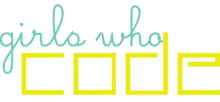Girls Who Code
Girls Who Code is a nonprofit organization which aims to support and increase the number of women in computer science by equipping young women with the necessary computing skills to pursue 21st century opportunities. The organization works toward closing the gender employment difference in technology, and to change the image of what a programmer looks like. They host a seven-week Summer Immersion Program, a two-week specialized Campus Program, after school Clubs, and a New York Times best-selling Penguin 13-book series.[1]
 | |
| Formation | 2012 |
|---|---|
| Founder | Reshma Saujani |
| Website | girlswhocode |
Summary
Girls Who Code was founded by Reshma Saujani in 2012 who came up with the idea of creating the organization during her run for the United States Congress when she noticed that schools along her campaign route lacked girls in computer science classrooms.[2] The organization runs programs during the academic year teaching high school girls computing skills like programming, robotics, and web design,[3][4] with sessions including projects and trips to companies like Twitter and Facebook.[2][5] There are now over 1500 Girls Who Code clubs across America, with the organization aiming to teach one million girls to code by 2020.[4] By December 2014, three thousand students had completed a Girls Who Code program, 95% of whom went on to major in computer science at university.[6]
The organization is sponsored by a number of software and technology companies including AOL, Google, and Microsoft,[5][7] and in August 2014 received a $1 million contribution from AT&T.[8] In 2015, Reshma Saujani collected a salary of $224,913 from the organization according to Internal Revenue Service filings.[9]
History
As of 2015, only 18% of computer science college graduates are women.[10][11] The founder of Girls Who Code, Reshma Saujani, believes that girls are raised to "be perfect" while boys are raised to "be brave".[12] Reshma Saujani participated in a TED Talk where she spoke about the consequences girls face in their future if they don't start taking risks.[13] She speaks of the tech industry and how she thinks there is a bias towards women in the industry. The company announced that in 2016 the non-profit organization will be expanding to all 50 states- making it the largest computing program for girls in the United States.[14] In August 2017, the nonprofit launched a 13-book series with Penguin Random House, including a nonfiction book, Girls Who Code: Learn to Code and Change the World, and several fiction books.[15] By the spring of 2018, Girls Who Code will have reached more than 50,000 girls with their computer science education programs.[16]
The organization's efforts to close the achievement gender gap has resulted in several honors. Saujani was recognized for 'her vision and efforts to close the gender gap in technology'.[17]
Partnerships
In 2016, Girls Who Code partnered with Accenture to work on the future of tech.[18] They subsequently released a report on recommendations to decrease the gender gap in computing. [19]
Girls Who Code has also announced they will be releasing an app on the Apple App Store.[20] This is intended to increase popularity and get more people involved.
Dell Technologies has partnered with the organization to support after school programs for young girls.[14]
On October 11, 2018, Girls Who Code partnered with TikTok starting the hashtag #raiseyourhand.[21] The app has announced to give US$1 for every video posted using the hashtag with a maximum of $10,000.[22]
References
- "Children's Middle Grade Hardcover Books - Best Sellers - September 10, 2017 - The New York Times". The New York Times. ISSN 0362-4331. Retrieved 2017-12-01.
- Guynn, Jessica (August 15, 2014). "No boys allowed: Girls Who Code takes on gender gap". USA TODAY. Retrieved February 15, 2015.
- Ross, Christopher (November 5, 2014). "Reshma Saujani's Ambitious Plan for Technology". Wall Street Journal. Retrieved February 14, 2015.
- "Aiming for 1 million "Girls Who Code"". CBS News. December 11, 2014. Retrieved February 15, 2015.
- Buhr, Sarah (December 14, 2014). "Girls Who Code Expands To Get More Young Women In Computer Science Majors". Tech Crunch. Retrieved February 15, 2015.
- Dockterman, Eliana (July 31, 2014). "Cracking the Girl Code: How to End the Tech Gender Gap". Time. Retrieved February 15, 2015.
- Bilton, Nick (June 26, 2012). "Tech Companies Announce 'Girls Who Code' Initiative". Bits Blog. The New York Times. Retrieved February 16, 2015.
- Tone, Ca-Ching (August 27, 2014). "AT&T Gives $1 Million to Girls Who Code". The Daily Beast. Retrieved February 15, 2015.
- Guidestar. "IRS Form 990 Girls Who Code Inc" (PDF). Retrieved April 24, 2017.
- Vu, Shana. "Cracking the code: Why aren't more women majoring in computer science?". UCLA Newsroom. Retrieved 2018-10-25.
- "Girls Who Code - About Us".
- Saujani, Reshma, Teach girls bravery, not perfection, retrieved 2016-10-27
- "Teach girls bravery, not perfection". 2016-03-08.
- [the largest computer science program for girls in the U.S.! the largest computer science program for girls in the U.S.!] Check
|url=value (help). Missing or empty|title=(help) - Alter, Alexandra (2017-08-21). "Teaching Kids Coding, by the Book". The New York Times. ISSN 0362-4331. Retrieved 2017-12-01.
- "Girls Who Code free after school Clubs launch for 2017-2018". girlswhocode. 2017-10-04. Retrieved 2017-12-01.
- "Law Firm Awards 'Girls Who Code' Founder".
- "Cracking the Gender Code in Computing - Accenture and Girls Who Code". www.accenture.com. Retrieved 2018-10-25.
- "Cracking the Gender Code - Research from Girls Who Code & Accenture". girlswhocode. Retrieved 2018-10-25.
- "Girls Who Code Debuts App -- THE Journal". THE Journal. Retrieved 2016-10-27.
- "Girls Who Code Releases Digital Visual Album Celebrating Sisterhood, Empowering Girls". Girls Who Code. 2018-10-08. Retrieved 2019-06-15.
- "TikTok announces support for Girls Who Code". TikTok. Retrieved 2019-06-15.